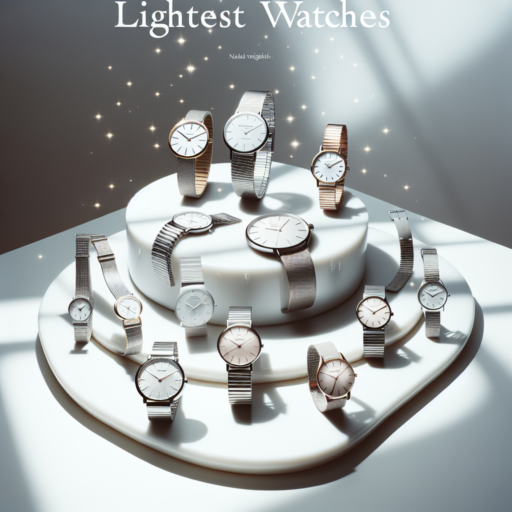What is considered a lightweight watch?
Defining a lightweight watch often revolves around the overall weight and feel on the wrist, rather than a strict numerical standard. Typically, watches weighing less than 100 grams are categorized as lightweight, providing an almost imperceptible feel for day-long comfort. These timepieces blend innovative materials and minimalist design elements to shave off unnecessary grams without sacrificing style or functionality.
The quest for lightweight watches has led manufacturers to employ advanced materials. Materials like titanium, carbon fiber, and advanced polymers are favored for their strength-to-weight ratios. Titanium, for instance, offers a significant reduction in weight compared to stainless steel, while maintaining superior durability and resistance to corrosion. This makes it an ideal choice for both casual and luxury watches seeking to minimize heft.
In addition to material innovation, the architecture of a watch plays a crucial role in its weight. Designers focus on slim profiles and streamlined components to further reduce bulk. The incorporation of digital or hybrid movements over traditional mechanical innards can also contribute to a lighter frame, offering functionality without the weight. As a result, lightweight watches not only appeal to the aesthetics but also cater to the practical needs of users looking for comfort, especially during active or extended wear.
What is a light watch’s weight?
Understanding the weight of a light watch is crucial for both enthusiasts and the everyday wearer. Typically, a light watch weighs between 50-100 grams, which offers a perfect balance of comfort and durability. This category often includes materials like titanium or lightweight alloys, and sometimes even advanced composites designed to reduce weight without compromising on strength. A focus on slim profiles and efficient design further contributes to the lightness of these watches.
Materials and Design Influence: The choice of materials plays a significant role in the final weight of a watch. For instance, titanium is renowned for its strength-to-weight ratio, making it a popular choice for those seeking lighter watches. In contrast, stainless steel, while durable, often results in a heavier timepiece.
The architecture of the watch also impacts its weight. Slimmer designs with minimalistic features tend to weigh less. Manufacturers might also incorporate materials like carbon fiber into the dial or strap, which not only adds a modern aesthetic appeal but also cuts down on weight. This approach allows for the production of watches that are both light on the wrist and visually striking.
What are the thinnest watches made?
In the world of horology, the quest for creating the thinnest watches has been both a challenge and a significant achievement for many watchmakers. These marvels of engineering and design are not only a testament to the brands’ craftsmanship but also offer a sleek and elegant aesthetic that appeals to many watch enthusiasts. The thinnest watches are often made using advanced materials and pioneering technology to reduce the size of the watch’s movement and case without compromising on its functionality or durability.
Several high-end watchmaking brands have made headlines over the years for producing some of the thinnest watches ever seen. For instance, materials like titanium and sophisticated alloys are commonly used for their combination of lightness and strength. Moreover, the intricate craftsmanship involved in designing these watches requires a profound understanding of micro-mechanics and innovative engineering techniques. It’s not merely about making the components smaller but also reimagining the watch’s interior architecture to optimize space efficiently.
Key Innovations Behind Thinnest Watches
The creation of the thinnest watches is heavily reliant on key innovations in watchmaking. This includes the development of ultra-thin movements, known as calibres, which are the heart of the watch and dictate its thickness. Brands have pushed the boundaries by creating manual and automatic movements that are only a few millimeters in depth, a feat that demands extreme precision and expert craftsmanship. Additionally, the use of monolithic crystal oscillators as a substitute for traditional escapement mechanisms has been a game-changer in reducing thickness. These innovations not only highlight the incredible technical skill of the watchmakers but also their relentless pursuit of excellence.
No se han encontrado productos.
What is the most weighted watch?
Discussing the most weighted watch in the world brings us to a unique intersection of horology and heavyweight engineering. Watches, often celebrated for their intricate craftsmanship and aesthetic appeal, have rarely been the center of attention for their heft. However, a few exceptional timepieces have shattered the norms, setting records not just in precision but in weight as well.
The question of the most weighted watch doesn’t have a straightforward answer, as it encompasses various categories, including wristwatches and pocket watches. Within these categories, specifics such as the material of the case, the strap or chain, and the mechanical components inside play significant roles in contributing to the overall weight. The incorporation of heavy metals like platinum and gold, alongside the embellishment with gemstones, further adds to the mass.
Moreover, the functionality of the watch also plays a pivotal role in determining its weight. Advanced mechanical watches with a plethora of features, commonly known as complications, can significantly increase the weight due to the complexity and the number of parts involved. Diving watches, designed to withstand tremendous underwater pressure, often boast extra-sturdy and consequently heavier cases. These factors collectively contribute to making a watch notably hefty.

